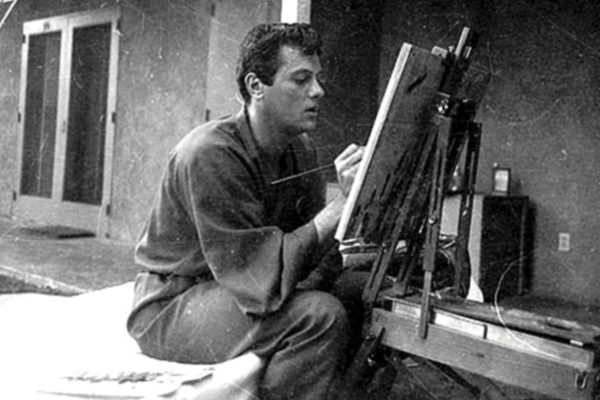Continued (page 3 of 4)
If we thought the descent into the canyon was difficult, we were mistaken. Though the rest of the trail is relatively flat (you climb 400 feet over six miles), we were hiking in sand and mud, both of which slow you down more than you realize. We were warned about quicksand, and that certainly was no joke. Pockets of quicksand form around large boulders and in the creek bed, so staying alert is essential. It’s reported that the trail crosses Laguna and Keet Seel creeks 32 times, but it felt like at least twice that to us. Both creeks were only about two inches deep – just enough water to wet our boots but not enough to provide any relief from 100-degree temperatures. Not that you would necessarily want to cool off in the creeks once you spy the creatures living in the water. The canyons are home to herds of cows and even wild horses (we spotted a cluster of skittish horses on our hike out), and the creeks are studded with cow manure. Mosquito larvae (yes, West Nile Virus has been found in these canyons) and spiders skittered along the top of the water, and long worms swam in the shallow, clay-filled depths.
During our orientation, we were warned about mountain lions in the canyon, and sure enough we spotted the big cats’ tracks in several locations (as if the worms weren’t enough). At one point, we turned around only to find a silent coyote following us. But it wasn’t the worms or the possibility of being mauled that bothered us most; it was the heat. We were hiking in the canyon in the late morning, and there was no shade. We ate our lunch sitting in the sand, hunched up against a boulder, hoping for some relief and finding none. And then we trudged on, our boots heavy and caked with mud, not another soul in sight. After five miles, we came to the first – and the largest – of three waterfalls. The 35-foot cascade provided our sun-drenched spirits with a bit of relief, but to circumnavigate the waterfall we had to climb up a steep sand dune that left us all breathless and cranky.
The next two waterfalls, located at the 6- and 6.5-mile points respectively, were much smaller, and we simply hiked across the tops of each one. By far, the last two miles of the hike were the worst, and that certainly had everything to do with our exhaustion. We stumbled into a primitive campground (that required another sandy climb) and dropped our backpacks at the closest campsite nearly eight hours after beginning our hike. We were grateful for the shade provided by tall trees, but we were dismayed to find swarms of flies and mosquitoes buzzing around our heads.
Keet Seel/Kawestima (Keet Seel means “broken pottery” in Navajo) is located another quarter mile from the campground. You are not allowed in the ruins without a ranger. When we made our reservations, we were told we needed to be at the ruin by 5 p.m., but during our orientation we were told tours were only offered until 3:30 p.m., just one of the many inconsistencies we had come across while planning this trip. We arrived at the campground at nearly 4:30 p.m., not even sure if we were going to be allowed to tour our destination. Lucky for us, the ranger, who lives alone in a cabin at the base of the ruins, took pity on our bedraggled group and agreed to give us a tour even though it was late in the day.
And Keet Seel/Kawestima was absolutely spectacular.
Unlike other cliff dwelling sites in the Southwest – Mesa Verde included – the vast majority of the Keet Seel/Kawestima ruins are authentic and not rebuilt (with the exception of the retaining wall). Like most cliff dwellings, it’s nestled high in an alcove to protect the dwelling from the elements. A hushed silence fell over our group as we rounded a corner and looked up into the village. Its open windows stare out over the canyon like watchful eyes, almost like the structures are waiting for the return of the village’s inhabitants. In fact, the Hopi believe the people who once lived at Keet Seel/Kawestima intended to return. A white-fir log was placed horizontally across the village’s entrance, and the Hopi say the trunk is symbolic of shutting and locking the door to your house when you leave to go on vacation.
After hiking nearly nine miles, the last thing we wanted to do was climb a ladder, but the only way into Keet Seel/Kawestima is to climb a 70-foot (think seven stories) wooden ladder. The climb up made us dizzy, but the backward climb down was even more heart-pounding. Once we were in Keet Seel/Kawestima, we had the entire village to ourselves. The ground surrounding the homes, granaries and three kivas (round rooms typically located below ground and used by the Pueblo tribes for religious ceremonies) is littered with ornate pottery shards, pieces of rope and scores of decaying corncobs. Two large pots, almost entirely intact, sit on top of a roof. Pictographs depicting men in headdresses, animals, handprints and even a kokopelli-like flute player adorn the walls in colors of red, blue, white and yellow. We climbed through doorways and into homes that still retained their wood-beamed ceilings and thatched roofs. We gazed down a narrow pathway that the ranger told us served as the village’s street, and we climbed down an original ladder to peer into a kiva. Above all, we approached the entire site with reverence because it was obvious the spirits were keeping an eye on our little group.



